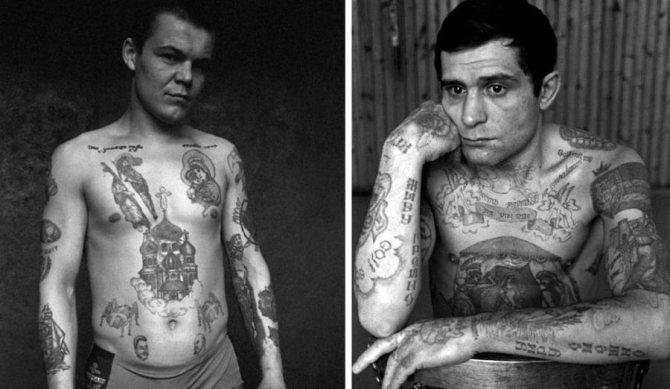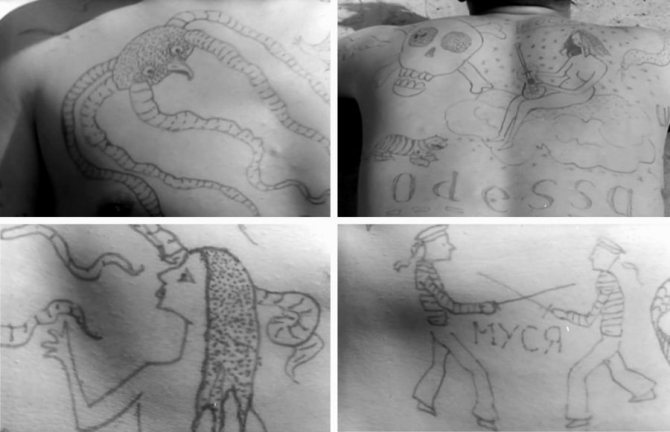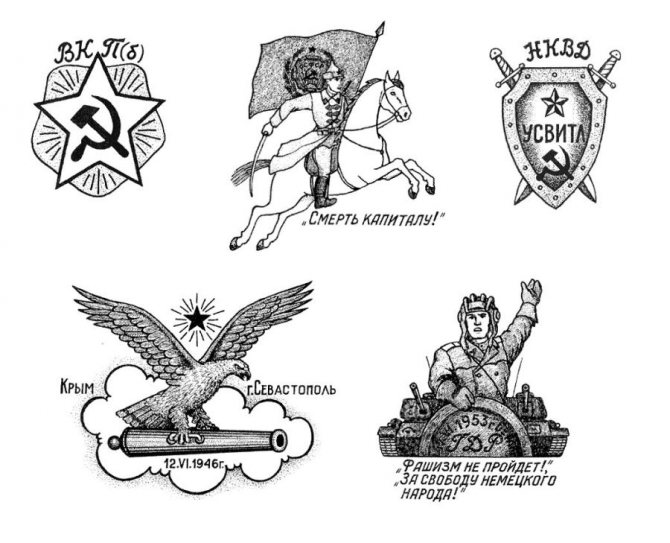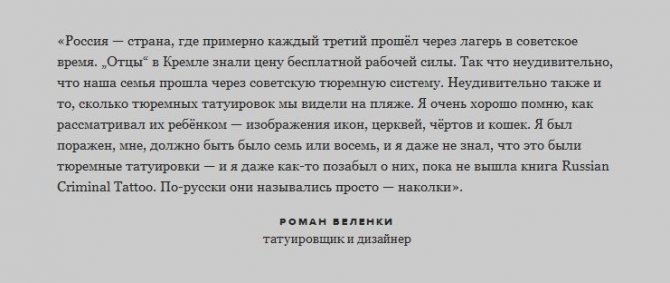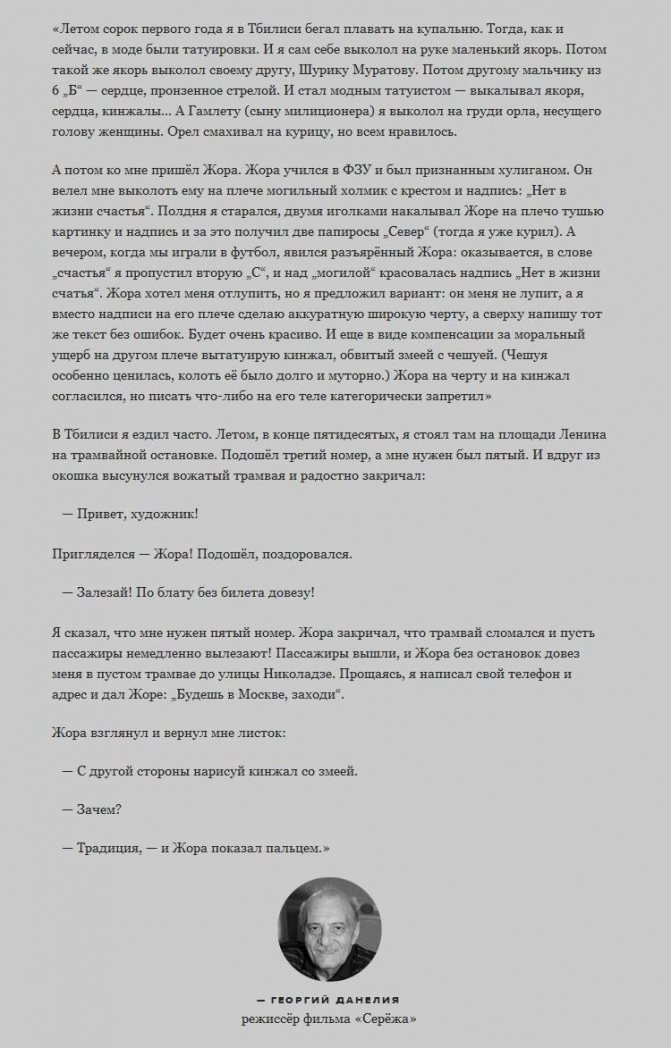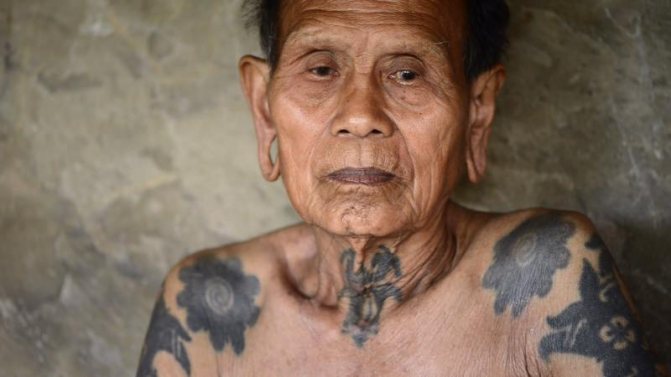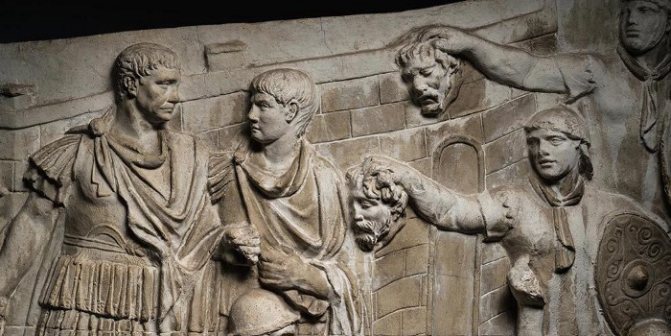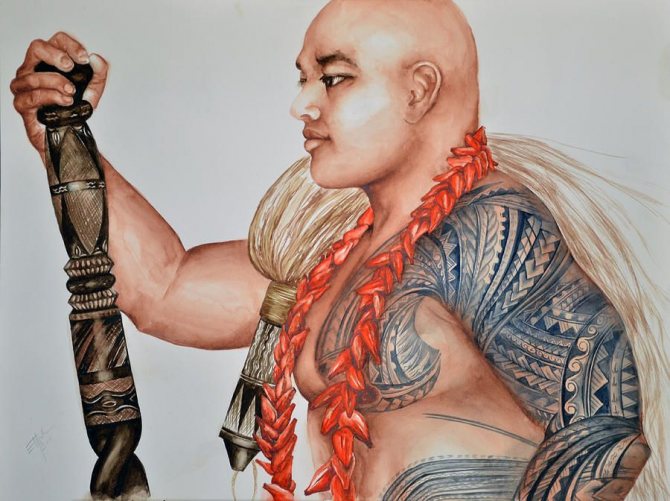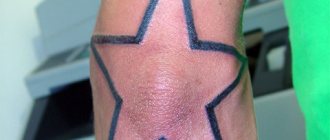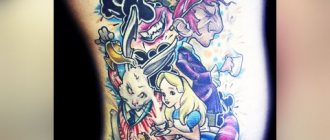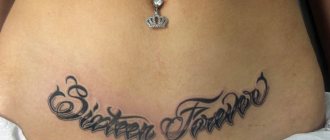The history of tattoos has many thousands of years, from the moment a person began to live in society with other people. The most ancient tattoos were found by researchers of Egyptian tombs and pyramids. Tattoo, at all times, was usually applied not only as a decorative ornament on the body, but was in some cases a sign of family, totem, tribe.
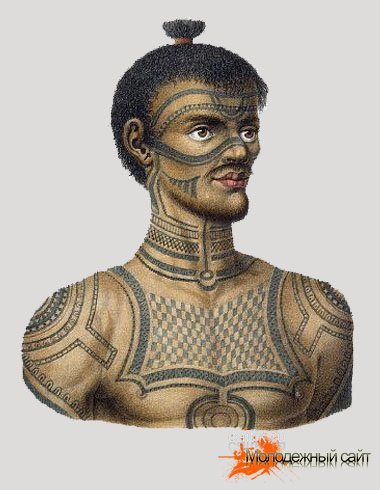
By it one could find out the social affiliation of its owner. It was also believed that a tattoo could endow its wearer with magical power. Thus, the ancestors of the Vietnamese, wishing to escape the attacks of sea animals, put on their bodies tattoos depicting a dragon.
The first tattoos in Russia
In Russia, the history of tattooing starts from the traditional Soviet camp and army tattoo, still a big part of it among all. The emergence of prison tattoos takes its historical past from camps and prisons, that is where the specific tattoo culture originated. The motifs and themes of prison tattoos have varied, from cave paintings to imitations of the famous Italian artist Leonard Da Vinci. The army tattoo is more understandable, as it usually depicts the branch of the military, the year of service, and the blood group. Anchors, sails or seagulls - these navy tattoos were mostly done to themselves by sailors, using nautical stylistics in them.
In the last few years, tattooing in our country has succumbed to the increasing influence of Eastern countries and the West. In tattooing over time, many trends and styles emerged of which we did not know before. Along with the emergence of a new economic and political order in the country, new aesthetics and ethics emerged. Today there is literally a real explosion in the popularity of tattooing. In tattoo parlors come people of different ages, professions, social status and order tattoos of different sizes and styles, on different parts of the body. Popularity most enjoy all kinds of images of hieroglyphs, ornaments, fantastic characters and monsters, some collages of real or fabulous plants.
Among young people, of course, the most popular is a decorative tattoo. The decorative tattoo is made in any style depending on the desire of its future owner and usually does not carry any information about him, serving only as a decoration. In such tattoos involved animalistic subjects in the form of images of animals, insects, fish, birds, as well as plant motifs associated with the plant world (eg a plant ornament). It happens that there are interesting tattoos in the style of "bio-mechanics," where a combination of body and machine elements are used.
Sources and Literature
- Brockhaus and Efron Encyclopedic Dictionary (in 86 volumes)
- The magazine "Around the world", № 10 (2841) / Ivan Grinko: The signs of chivalry and plebeian rebellion
- Legal Russia, a federal legal portal / D. P. Zakharov: Mikhail Nikolaevich Gernet (1874-1953)
- National Geographic Russia. Issue: Summer 2007.
- Iceman photoscan, The mummy's tattoos
- Secrets of the "Iceman" // Chishki.net, October 25, 2011
- Schiffmacher Henk, Reimschneider Burkhard "1000 Tattoos", Taschen, 1996. - 704 s.: seite 24.
- Website for the History of Costume. History of tattooing from primeval times
- Jelski Andrzej Tattoo / Translated from Polish. - Minsk: MET, 1997. - 232 с.
- Svarga - Russian culture, traditions, customs, crafts / Rombo-point ornament. Excerpts from the book by B. Rybakov "Paganism of the ancient Slavs".
- Tattoo Archive about Samuel O'Reilly
- "Para Bellum" - blog devoted to military subjects / Military Tattoos
- OpenSpace.ru - archive. Mikhail Buster 10/05/2012 Group with a tattoo.
- Vyacheslav Kolominov: Rebellious inclinations. // "Vokrug Sveta" magazine, #4 (2679) | April 1997
- Ratmanov Makar Ivanovich (1772-1833).
- Nancy Condi The Graphic on the Body.Tattoos and the Collapse of Communism. (Translated from English by N. S. Vnuchenko) / Published in: "UFO" 1999, #39
- OpenSpace.ru - archive. Mikhail Buster
- The case of E.P. Vakhrushev // Site "Tattoo Pepper"
- Khasiev U.A. Formation of Russian organized crime / Site of diplomas and term papers: article
- Iosif Davydovich Kobzon - biography. From the book by F.I. Razzakov "Dossier on the Stars 1962-1980".
- Gleb Timofeev Mind Needles: RS finds out what people will do at the International Tattoo Convention // Roling Stone, May 17, 2012.
Ethnic Tattoos
Ethnic tattoos are associated with the ornaments of cultures from around the world. For example, it can be Chinese characters, oriental patterns or Indian tattoos. A lot of people give their sympathy in the direction of graphic contour drawings in the style of "black wave", but nevertheless, the greater popularity of Japanese and Celtic tattoos.
Erotic tattoos increase the sexuality of the body. All kinds of erotic images, pictures and inscriptions are applied, most often, in the intimate areas and genital areas - the shoulder, chest, sacrum, pubis and so on. The male gender often tattoos the biceps and shoulder with circular ornaments. It may be noted that in the past the tattoo culture in our country was totally male, but now more and more often the actual bearers of tattoos are also the female sex. This is just largely due to the tattoos of erotic nature.
Depp's personal diary: how to turn "Winona" into "Wine"
Johnny Depp is probably one of the most tattooed stars. The actor claims that for him drawing is like keeping a personal diary. His body depicts the main moments of his life: for example, on his right arm Depp has a tattoo of an Indian chief - a symbol of the fact that the blood of the Native Americans flows in him. The actor also has a tattoo in honor of former lover Winona Ryder - "Winona Forever," but after the breakup, Depp changed the inscription to "Wine Forever." The names of the children and mother are also imprinted on the star's body. This is only a small part of the images, the meaning of the rest of the tattoos Depp prefers to keep secret.
To learn more about the history of tattooing and to see the exhibition of the Pushkin Museum exhibition, you can in social networks on the hashtag #NaedinesPushkinsky.
Join the club
Why do people get tattoos?
According to psychologists, a tattoo gives its wearer a sense of individuality and their own uniqueness. In ancient times tattoos on the body were worn only by the elite, and in our time it is available to many people of different ages and has become a kind of fashion trend. However, also psychologists argue that there is another side to the coin. They believe that the tattoo has not only a decorative function and is the adornment of the body parts, but also imposes a trace in the psychology of its bearer. For example, a person who possesses an aggressive tattoo, as if imperceptibly embracing himself with a hidden barrier, the tattoo very often reminds him: I hate the whole world, I am angry at everyone.
The tattoo, was a kind of imitation and adherence to a cultural lineage or someone else's will, the assumption of any obligation. In the history of the tattoo there is something similar to a kinship brand, which represented some characteristic quality of its owner, his desires. Much of the problem is that a person as he grows up can change, his value principles, aesthetic tastes, and other views on life can change. In this case, the coveted in the past beautiful and stylish image becomes like a foreign stain on the body. According to statistics, most of the half of the people who have had a tattoo, want to get rid of it and remove it. There may be many reasons for this such as: a revaluation of values, changes in social circles and preferences in life, perhaps someone has high demands at work, and someone is just tired of the same invariable drawing on his body.
Before you decorate your body tattoo, it is recommended to remember and know that there are tattoos, which require from its owner certain appropriate qualities and rights. For example, imitating or copying a tattoo with elements of a criminal environment, can be extremely bad consequences. Such criminal tattoos serve as a sign of recognition, indicating the criminal affiliation or position of the wearer. If the bearer of such a tattoo has nothing to do with the criminal world and accidentally ended up in places not so distant, it can end up very badly for him. The point is that the place with the tattoo can be cut off along with the skin. This also applies to ethnic clan tattoos, you have to be more careful with such images.
How and what the tattoos were made for
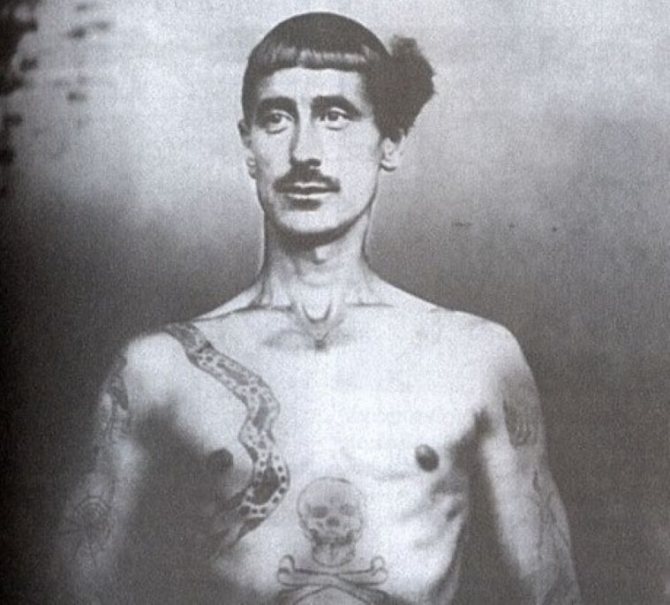

Historians believe that most often tattoos were applied by magi. They were pagan priests who were able to communicate with spirits and conduct magical rituals, in which they were helped by tattoos. For their drawing used special tools made of animal bones or some species of trees, considered sacred.
It is worth noting that tattoos served not only as amulets. By them you could also understand which category a person belonged to, and that means you could understand the hierarchical structure of the society. But after the baptism of Russia by Vladimir the Great and the adoption of Orthodoxy, tattooing was strictly forbidden. But in some regions, such as the Balkans, the tradition continued to observe, where it lives to this day.
Temporary tattoos
Not so long ago began to appear the so-called "temporary tattoos". Such a tattoo can decorate, any part of your body, for a certain time, whether it be for one evening to go to a party or go to the resort, well as other various reasons. Get rid of the temporary tattoo can be painless and effortless.
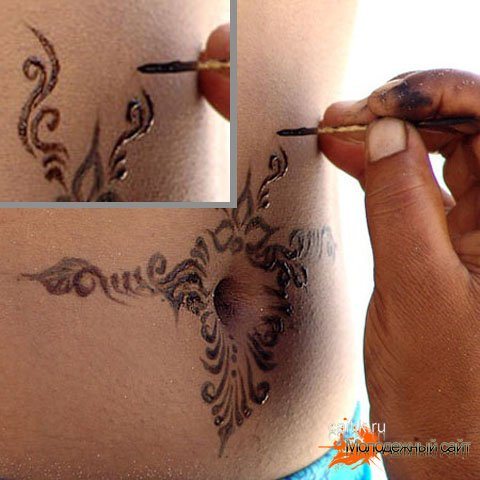

There is a transfer paper Lomond Tattoo - it is a self-adhesive film on a paper base. Its main advantage over the classic temporary tattoos is that the material does not need to use water and is transferred by dry method. This material can also be used as an ordinary sticker. In one set with the transfer paper Lomond Tattoo, manufacturers prepare a CD, which contains a huge selection of tattoo designs for every taste, a variety of motifs, styles, subjects and trends. Images can be edited in any graphic application to make them unique. They will be presented in vector and raster form.
In the hands of the wearer, the Lomond Tattoo kit and tattoo CD is a good creative tool. It also introduces its owner to tattoo styles in different cultures in many countries around the world, and helps to increase their own creative skills in modifying graphic images, making it possible even at home to make a tattoo with the addition of unique parts of their imagination.
Where do the roots of tattoos go
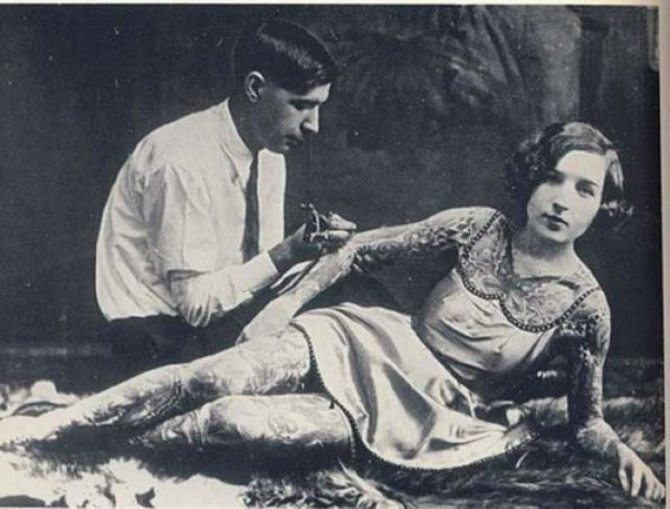

It all started at the beginning of the 10th century AD. Approximately in 921-922 year on the territory of Russia arrived traveler from Baghdad Ibn-Fadlan. Later in his works, he gave a description of local residents, which said that their bodies were covered with numerous drawings. Most of them were amulets designed to protect against dark forces and misfortune, to attract wealth, to give power, etc.
The most interesting thing is that the tattoos covered a vast area. They started from the very fingers of the hand and reached as far as the neck. Based on this we can conclude that tattoos were a common practice for our distant ancestors. But they were not made for the purpose of decoration, but had a deep meaning.
Three mistakes of an ideal woman, after which her man begins to "wipe his feet"
Starting treatment right away is a sure way to save money on dental care, doctor says
Actor Yury Stoyanov blamed the law on the credits in the "death" of "Town
The beginning of tattoo history in the 21st century.
2000s.
At the beginning of the 21st century, the popularity of tattoos on the lower back increased. The so-called "tramp stamp" became one of the most fashionable places for women to get tattoos. Butterfly and Yin-Yang symbols also became widespread.
Celebrities continued to develop tattoo trends throughout the 'noughties. Celebrity tattoos became popular, mostly thanks to singer Rihanna.


The 2010s
Up until now, the 2010s have seen trends in both design and placement of tattoos. Small tattoos in unusual places such as fingers or behind the ears are now very popular. Many people choose quirky and creative designs.
One of the most popular designs for small finger tattoos at the moment is the odd mustache. Other popular trends include the infinity symbol, feathers, and increasingly popular tribal tattoos.
Time of origin and reasons for appearance
Scientists who study the history of body art believe that tattoos date back to the time of the primitive communal system, more than 60,000 years ago. This is evidenced by the ancient rock art that tells the story of people's lives and depicts their life and appearance. During the study of the Egyptian pyramids, mummies 4,000 years old were discovered with barely discernible drawings on their skin. Supposedly tattoos were the hallmark of rich pharaohs and noble families. Ordinary Egyptians were not awarded such an honor. So, the time of origin of tattoos is very remote from us, so you can be rightfully proud of the fact that you have joined the ancient culture, if you want to make a tattoo.
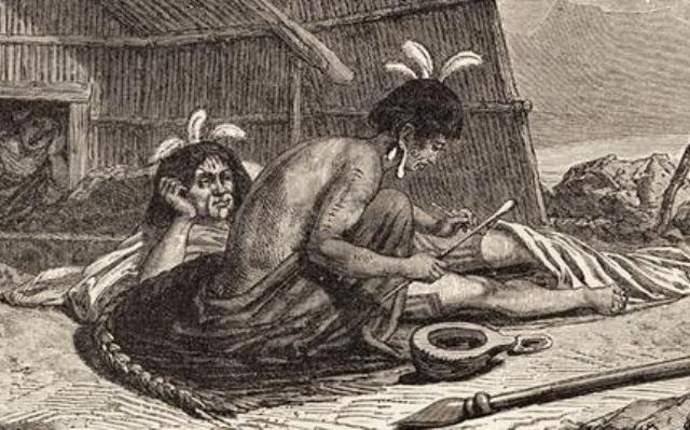

According to the history of the origin of tattoos, they may have been applied in the following situations:
- During the hunt, men received natural injuries - scars, abrasions, wounds. Over time, the skin became coarse and deformed, forming bizarre patterns. Such patterns spoke of the bravery, courage, and hunting spirit of the wearer, and he became a respected person in the tribe. Then the cuts began to be applied artificially and soon spread even to women, becoming the first tattoos.
- Tattoos were forced on every member of the community and indicated their social status, tribal affiliation, outstanding achievements, deeds and character traits. Tattoos had both positive and negative meanings. A person's body reflected his whole life, for others he looked like an open book where nothing could be hidden or embellished.
- Tattoos had a sacred meaning and were associated with transitional ceremonies: initiation into man or leaving for the next world. Tattoos were applied from a very young age and sometimes ended even after a person's death.
Ancient people were pagans, worshipped idols, deities and invented ways to protect themselves from the influence of evil forces. Body painting was just one of these methods and served as a powerful amulet, attracting good luck and warding off spirits.
Video about the history of tattoos
History of tattoos in the 19th century
Tattoos were not widespread or socially acceptable until the mid-20th century. Until that time, they were reserved for a small population, mostly those working in the entertainment industry. Fully tattooed people became a popular attraction in themselves.
John O'Reilly.
One of the most famous tattooed men of the 1800s was John O'Reilly. His sophisticated and full body made him a popular subject in museums and the circus, where his tattoos attracted and amazed audiences.
John O'Reilly was known as "The Tattooed Irishman," and he had many elaborate tattoos covering his entire body. One of the earliest mentions of O'Reilly's tattoos was in an article from the Brooklyn Daily Eagle.
The February 22, 1887 issue covers his performance at a boxing match. They mention that his tattoos are "disgusting" and are a reflection of his "barbaric practices."
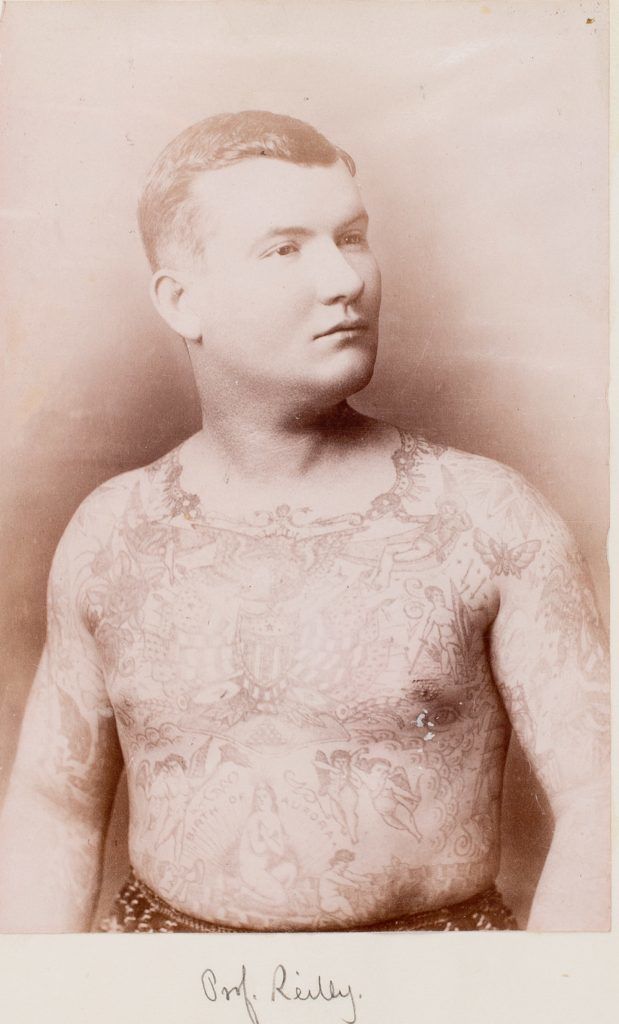

Emma de Burgh
Emma de Burgh was a famous tattooed lady in the entertainment industry in the late 1880s. She worked alongside her husband and both were painted by the same tattoo artist as John O'Reilly. De Burgh and her husband also became very popular performers in the world of musicals in Europe.
They appeared in Berlin, Germany, in 1891 and continued to surprise European crowds for several years. Their tattoo designs had many religious connotations, including references to the Last Supper and Calvary.
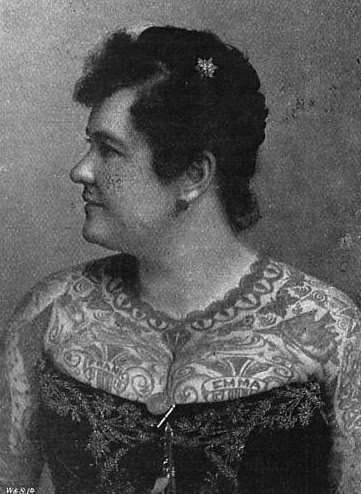

Tattoo History in the 20th Century
Throughout the twentieth century, popular tattoo styles evolved and changed. To examine the evolution of ink in more detail, we've broken it down into decades. Let's take a closer look at the artistic evolution of tattoos in Western culture over the last hundred years.
The 1910s.
In the early 20th century, most tattoos were found on circus performers or sailors. Tattoos were used to tell someone's personal story as well as their profession. For example, it was common for a sailor to have a tattoo of an anchor.
In the sailing community, tattoos also became a sign of belonging. Young sailors would be tattooed after joining, almost like an initiation ceremony to welcome them aboard.
From there, the traditional art form continued to grow and had a somewhat practical purpose. Many tattoos were used for identification if sailors fell overboard or drowned.
Sailors had tattoos at different ports where they were going. The tattoos symbolized different destinations as well as the length of their voyage. A turtle tattoo would signify that the sailor had crossed the equator, and swallows symbolized a 5,000-mile journey.
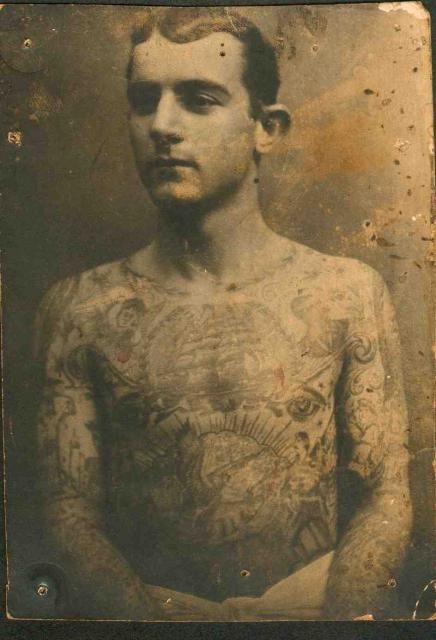

The 1920s
Throughout the 1920s, cosmetic tattoos became very popular among women. Many got popular makeup trends tattooed on their faces because makeup was too expensive to buy. Common makeup tattoos included eyebrows and lip liner.
Traditionally composed tattoos were still less common in society and not very socially acceptable. It was mostly so-called outcasts, such as circus performers, sailors and criminals, who wore tattoos. They were so socially unacceptable that most women kept their cosmetic tattoos a secret.
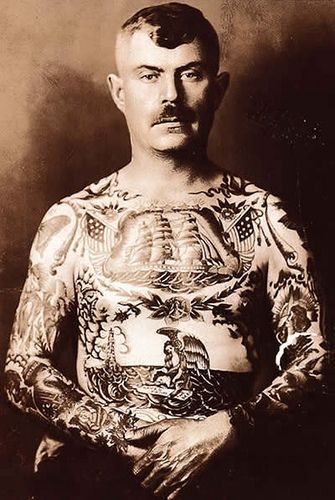

The 1930s.
Social Security numbers appeared in the 1930s, and everyone was told to remember their personal number. Many resorted to tattooing their social security numbers on their bodies so that they could always access them.
However, tattoos were still not socially acceptable. Those who got a tattoo with a Social Security number did so out of necessity rather than desire. Those who had Social Security tattoos were not viewed in the same way as people with more decorative and personal tattoos. Tattoos were still only used on artists, sailors, and criminals. Not for honest members of society.
In the 1930s, new theories emerged linking tattoos to repressed sexual desires. Albert Parry published a book arguing that the whole process of getting a tattoo was essentially sexual. With literature such as this, it is not surprising that tattoos were taboo during this decade.
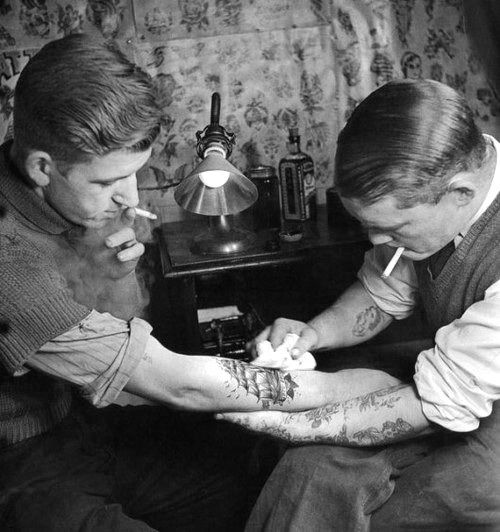

1940s.
The 1940s saw the birth of the iconic "Sailor Jerry" tattoo style created by Norman Keith Collins. He added color to tattoos by creating his own pigments and adding them to his tattoos. This decade's classic design had bold motifs and lots of color.
Thematically, the tattoos of the '40s were mostly centered around nautical or military motifs. There was also an increase in patriotic tattoos, thanks to World War II. It led to an increase in the number of women in the workplace, as well as an increase in the number of girls getting tattoos.
This fundamental shift in tattoo design led to an increase in the perception of tattoos. The increased popularity has led to decorative ink coming out of the shadows and becoming more popular than in previous decades. Many Sailor Jerry style tattoos are classic and timeless, and people still choose similar designs nowadays.
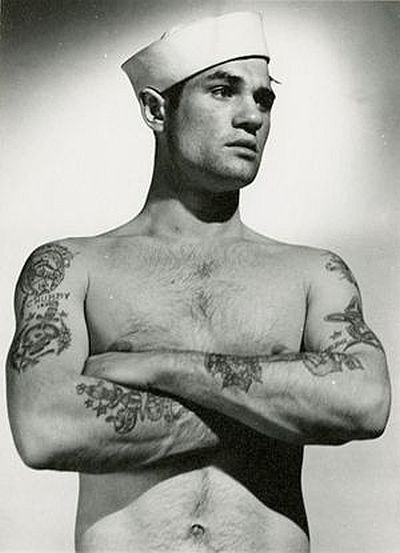

1950s
Throughout the 1950s, tattoos became a reflection of masculinity. Although it became fashionable, especially among the "bad boys," having a tattoo still put a negative social stigma on them. Those with tattoos were more likely to be labeled as criminals or thugs.
Society stepped back a bit and tattoos were again seen as the mark of the outcast. For those who continued to get tattoos, the trend of nautical tattoos continued through the '50s. There was also an increase in the popularity of chest tattoos during the decade.
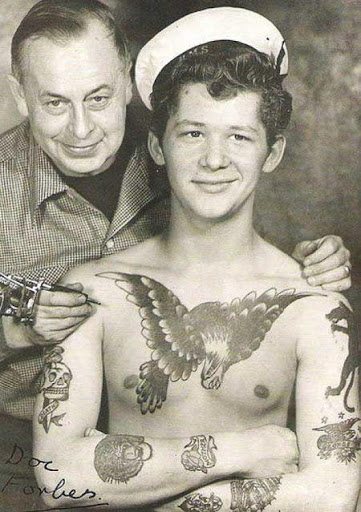

1960s
Tattoo parlors in New York City were blamed for the rise of hepatitis throughout the 1960s. While this may not have been true, it certainly created a negative stigma in the tattoo industry. It meant that many people avoided tattooing during that decade.
Nevertheless, the '60s saw a proliferation of tattooed idols in the media, with famous musicians such as Janis Joplin. Celebrities flocked to Lyle Tuttle, who was one of the best and most respected tattoo artists of the time.
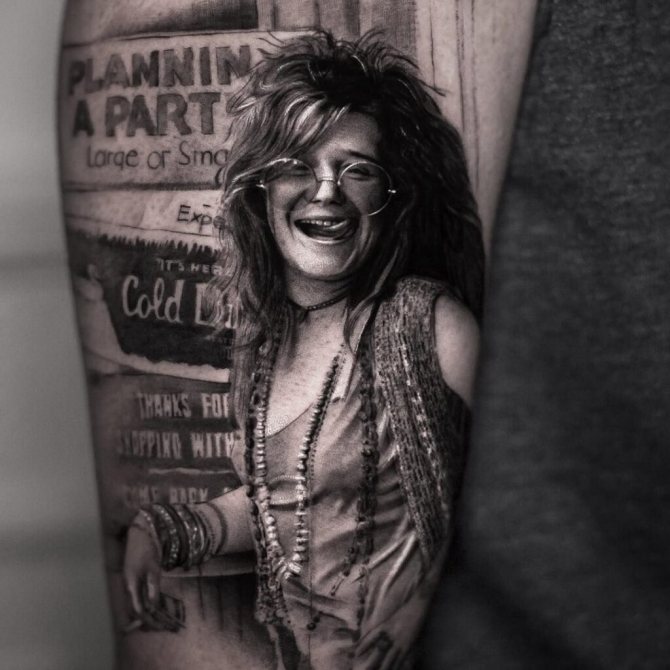

Patriotic tattoos grew in popularity thanks to the Vietnam War. Classic models of skulls and bones were especially popular among bikers.
1970s
In the 1970s, tattoos became more and more popular and popular. They were no longer reserved for the outcasts of society, now regular people wanted them too. Peace symbols and messages of peace were especially popular in this decade.
The '70s also showed a new style, with detailed and intricate designs gaining popularity. Young people involved in the counterculture began to appear in full-sleeved tattoos and bodysuits.
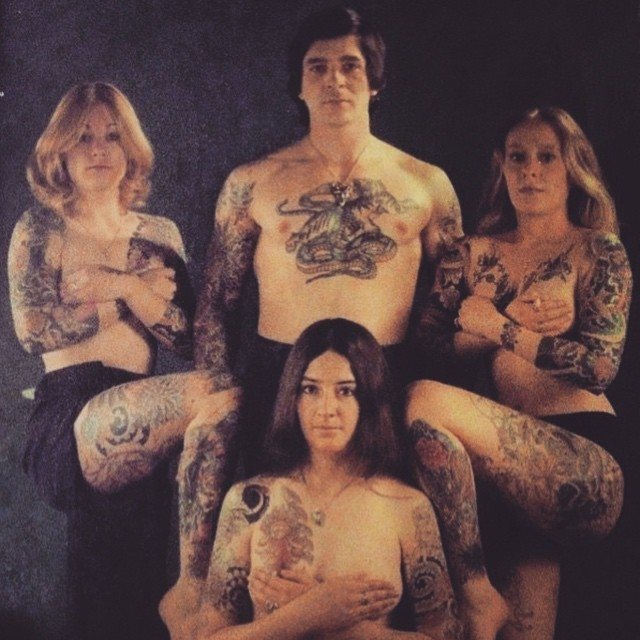

1980s
A decade of rebellion in the 1980s led to tattoos getting bigger and brighter. Eloquent black outlines, Celtic knots and colorful motif patterns became especially prominent. The music scene also influenced the thriving tattoo industry, especially rock and roll.
Many people got tattoos inspired by their favorite rock star's tattoos. By the '80s, society was leaning in, tattoos finally came into being, and tattoos finally became socially acceptable to most people. Because the stigma disappeared, more and more ordinary people got tattoos.
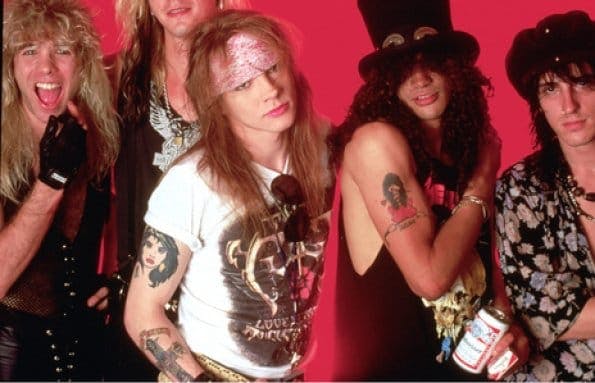

1990s
As in the 1980s, celebrities played a big role in the major tattoo trends of the 1990s. One of the most popular tattoo designs of the '90s was Pamela Anderson's barbed wire. Other popular drawings from this decade include tribal designs, Chinese writing, and sun tattoos.


Questions about the use of western-tribal and traditional tattoos began to be asked around the world. The rise of digital communications has contributed to global debates about ethics and appropriation.
Examine the tattoo artist's portfolio carefully
First and foremost, it is advisable to carefully examine the portfolio of the specialist you are interested in. This will allow you to understand whether his style of work suits you, the quality of his drawings. Also try to look at an independent "appraiser" to determine:
- Whether the work is sufficiently voluminous;
- whether the work complies with the proportionality;
- whether the right combination of colors;
- whether the play of shadows and shadows;
- How clear the contours are.
And most importantly - whether the drawings feel life! After all, it is the ability to breathe a little life into an ordinary drawing that distinguishes a good master from an ordinary artisan "craftsman".
By the way, remember that the services of a professional, experienced tattooist will cost quite a lot. But this is one case where saving money is not worth it. After all, the picture is stamped on for life! That is why there is no need to save - it is better to pay once a great sum than to spend all your money to fix a tattoo or to walk around with a disgraceful and disgusting image for the rest of your life.
Naturally, a good professional adheres to all hygienic requirements:
- uses disinfectant materials;
- works wearing gloves;
- does not mix paints;
- does not reuse consumables.
So you pay not only for the quality of drawing, but also for your safety, health and even life.
